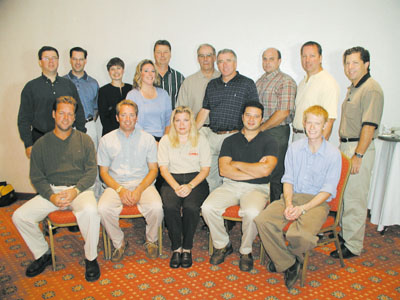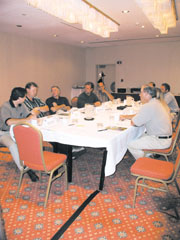
With the topics of Hispanic workforce challenges, insurance and builders’ expectations discussed at length, the next topic of the roundtable discussion involved issues that had a negative impact on the drywall contractors’ business. Not unlike the expectations of builders, the expectations of customers can be an issue.
“It’s what the builder is telling the customer. There’s a miscommunication in terms of expectation and reality. Some builders are awesome when it comes to customer service and they don’t let customers bully them.”
By “bullying,” the contractor refers to a situation like high-gloss paint that will be applied over an installation. This paint requires extra attention to detail on the part of the drywall contractor that takes additional time. However, the true nature of challenges presented by builders soon came out in the conversation.
“None of the homebuilders have to be qualified. There are builders out there with no training, no license—anybody can be a homebuilder. You just walk into the county building, give a set of plans, and take it to be approved by the fire marshal, pay your fee and build your house.”
It was mentioned that builders might demand drywall be hung in three days when it takes 10. A drywall crew may arrive to hang the house but the house failed inspection, causing the drywall contractor to send his crew elsewhere. The house passes the inspection two hours later and the builder is demanding to know where the drywall crew is, which of course, the contractor has sent to another job.

Board of education
A root of problems associated with customer services comes down to damaged board in the original installation. It was suggested that manufacturers could be more proactive and offer more input regarding the delivery of drywall, and develop some guidelines for its handling. “Tough edge” drywall and “cooked edge” drywall is all “just end-run stuff to get around the real problem of mishandling the drywall.” USG recommended that contractors talk to their suppliers regarding the mishandling of board.“It’s a maintenance problem, it’s hidden until some other time. Like deformed base paper that doesn’t show up until the paint is rolled on.”
The consensus was that manufacturers should offer guidelines on the handling, storage and on board handling, so that between the times it leaves the plant and the time it arrives on the job site it is still in close to pristine condition.
The next question put to the contractors was what sort of product innovations would they like to see. One response was “something in the mud, something one can mix in the mud to give it more elasticity,” not unlike some of the caulks currently on the market.
Another suggestion was for manufacturers to develop some sort of affordable machinery that would allow contractors to grind up drywall scrap. Manufacturers and contractors are still exploring drywall recycling in any form.
Customer education was offered as a way to improve the industry.
“Customers need to know how a house should be prepared before drywall crews get into the home. It would help us by putting more pressure on the builders. We have million-dollar homes being heated before we get there, dehumidifiers are running in the basement during the winter before we get there—and it’s like night and day in terms of the quality of how the job comes out.”
The roundtable was next asked to plug some of their favorite manufacturers. The list included USG, Straight- Flex, BPB Celotex, Briar Rock, Magnum, Georgia-Pacific, Ultra Flex, 3M and No-Coat. All agreed that it was important for the contractor to have a relationship with the manufacturer. It allows for communication of contractor concerns regarding product quality and pricing. Again, there was a definite request for more manufacturer literature. The consensus was that existing product literature is too general. There are so many factors to consider when troubleshooting and much of the existing literature covers bases broadly but not finely. For example, if heating causes the problem, there might be 10 variables to apply to the scenario, besides just the heat itself. The vagueness results in too much finger pointing in trying to assign blame.
It’s all drywall
Inevitably, the contractors were asked what brands of drywall they used. USG, BPB Celotex, Briar Rock, National Gypsum and G-P. were all mentioned. In fact, all admitted that they don’t really have a choice in what wallboard brand they get unless they specify a particular brand. Otherwise, the supplier will send the board the supplier has in stock.What is the difference between good board and bad board? The replies included a board with fresh paper edges and a great snap. The contractors agree that the fresher the drywall the better. Suppliers charge the same for whatever brand drywall is sent.
“The board should be put on the job much more neatly. We pay $5 or $6 a sheet for drywall, and it gets thrown here, banged up there, forklifts run into it, whatever. If it was paneling, like we used to do years ago, if a guy brought in a piece of panel with a chipped edge it would always go back to the supplier to be replaced. If I had to send back every piece of wallboard that was cracked on the edge or marked by a forklift, I’d never get anything done! Everyone should understand that a piece of drywall is a finished product. Just because we tape over it, cut it, texture it, whatever; it’s still a finished product. If the board is compromised, there may be service issues later on.”
However, it is in the finishing materials that the contractors agreed is the bread and butter. Texturing muds must match and be consistent, especially if the contractor is stuck with different brands on the same job. It’s all about consistency.
“Consistency means one load of mud must be the same as a load of mud sent six months later. Customers should be getting the same product: Finishers know their tools, they know how the mud’s going to come out of the boxes, how the texture’s going to go on and how much water to add. If one is forced to switch muds, or the mud is good one month and the next month, it’s a new batch with a new guy mixing it, it might come out different, and the texture might look different, and the builder is looking at me saying, ‘this is no good, you’ve got to redo it.’”
A minor debate broke out on the “box of mud vs. bucket of mud” situation. One contractor felt the mud that comes in a bucket is “way different” than the mud in a box and others felt that more mud came in a bucket than in a box—though the amount specified in the container is the same.
The next question put forth was whether or not the contractor would change suppliers if the supplier planned to stop carrying brands favored by the contractor. All concurred that they probably would but would “try to pressure the supplier” into keeping the favored product. However, changing suppliers raises all new concerns. A new supplier may have the brand but not the service that may in turn cause the contractor to switch back to the original supplier.
Remember the contractors
Another issue the contractors raised regarding the manufacturer relationship is to be careful cutting deals to homebuilders that go national. In other words, don’t sell a national builder drywall for less than what a contractor pays.“It disrupts the market and it will squeeze us out of the picture. The builders are going to try to beat the manufacturer’s price down, get us out of it and hire subcontractors directly. This could backfire, because the builder, having squeezed us out, is going to have to spend a lot of effort managing all the subs, which will make the manufacturer then want to sell to us again even cheaper. It’s a vicious circle.”
The drywall contractors would all like to see builders more educated to their specific issues of concern. It was suggested that Walls & Ceilings target builders with such concerns. This writer suggested that drywall contractors supply W&C with the information they feel builders need, have W&C present it whether written by the contractor himself as a guest writer or by a staff writer, and then present the information to the builders as part of a sales package. This way, a builder knows the contractors’ needs up front. (See the upcoming Industry Voices column by roundtable attendee, Rick Schwartz, regarding heating on the job site.)
The meeting wrapped with an overview of the industry’s trends. The Spanish and Latino construction population has nearly doubled in the last 10 years. One contractor said that 16 percent of all construction professionals are now Spanish or Latino. Thirty-nine percent of this number is drywallers, just under painters. All the contractors enjoyed the roundtable and felt it was very beneficial.
“It’s really neat to hear how all these things are impacting each of us in the real world and the different perspectives we bring to each other.” W&C

Report Abusive Comment